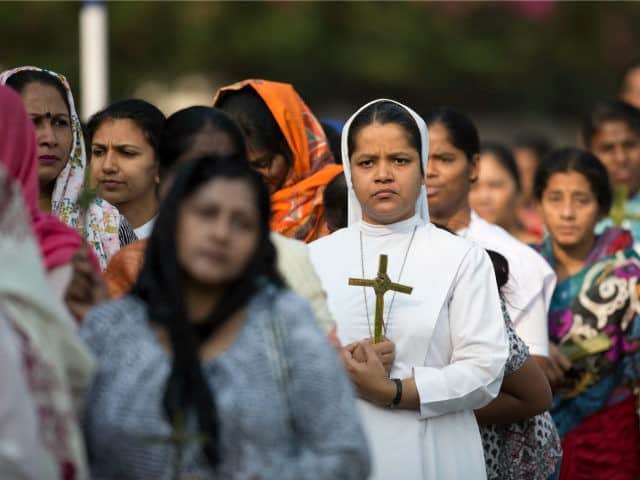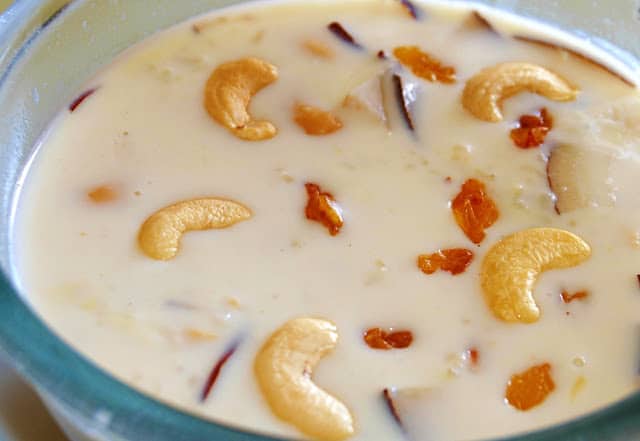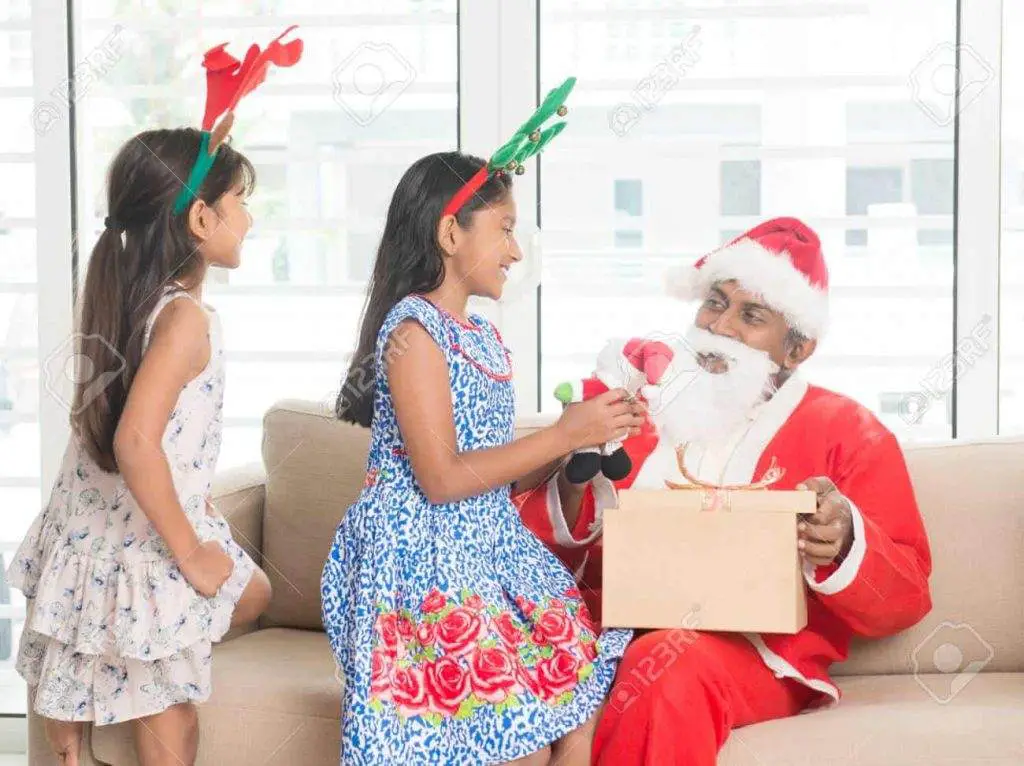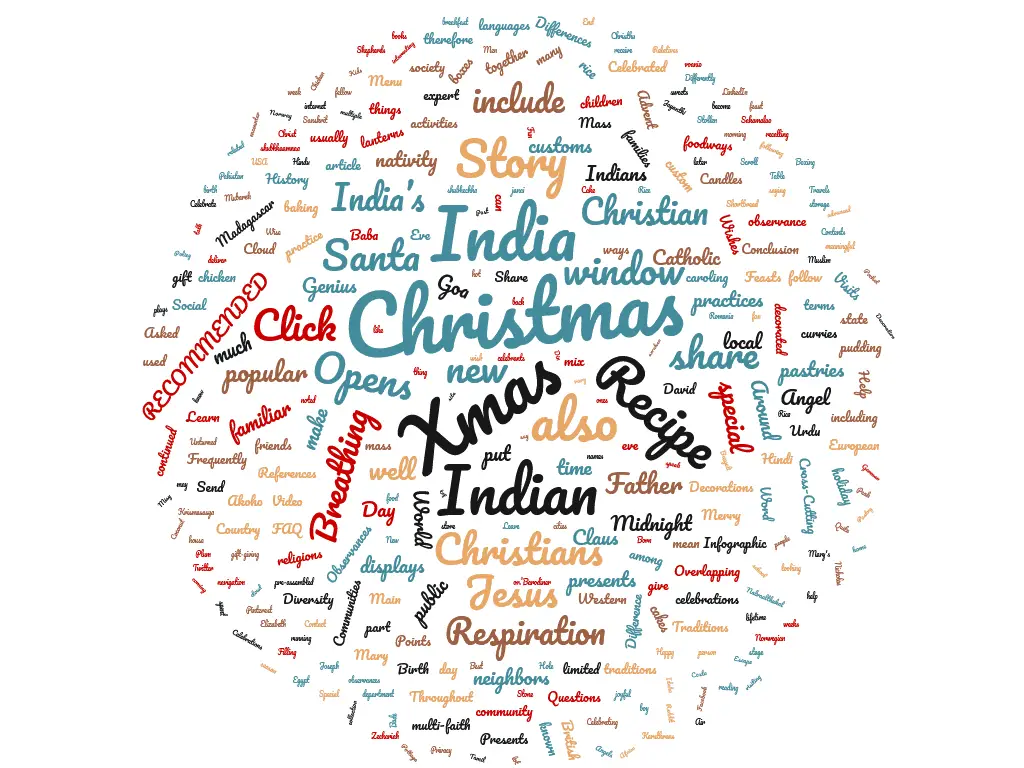Although Christmas is not a holiday associated with India, where the principal religions are Hinduism and Islam, the celebration of Christmas is very much a part of India’s diverse, multi-faith society.
Christmas first came to India through British and other European colonialism and the accompanying missionaries, but Christmas observance has continued well beyond India’s independence and establishment as a secular state in 1947.
Today, India’s twenty-five million Christians, who constitute five percent of India’s total population, have made Christmas very much their own, melding familiar Christmas traditions with local cultural practices and foodways.
Public Christmas celebrations are also enjoyed by Indians of all faiths, reflecting India’s tolerant and multi-faith society.
Christian Communities and Christmas Throughout India
The largest Indian Christian communities are located in Mumbai, Goa, and the state of Kerala, as well as Kolkata, which is known for its public Christmas celebrations.
Most Indian Christians are part of the Roman Catholic Church, and therefore follow Catholic religious practices when it comes to Christmas.

As with Catholics worldwide, therefore, Christmas in India begins on December 6, with Advent, honoring the announcement of the coming birth of Jesus by the Angel Gabriel to the Virgin Mary.
The Advent season is a time for attending special masses and also for home preparations for Christmas, especially of Christmas pastries.
Indian Christian women spend weeks doing advanced Christmas baking, and the time spent baking is also considered a time for intergenerational bonding.
Midnight Mass and other Christmas Eve Observances
Midnight mass is the most central observance of Christmas in India, and families make a practice of walking to mass together.
During Christmas, the churches are festively decorated with candles and Poinsettias.
Pre-mass public caroling processions are popular Christmas eve activities, as is visiting with family and friends and having celebratory drinks afterward.

Caroling traditions vary according to community and region, and among the Christians of Bhil, caroling is continued through the week and include the telling of the Christmas story!
But the most important post-mass Christmas activity is the Christmas feast.
Christmas Feasts and Decorations
Christmas foodways and other customs in India can be described as a mix of local and Western practices, and the degree of each depends on the community.
For example, some Indian Christmas dinners, notably in Goa, feature roast turkey or chicken, or even the very British plum pudding, revealing how much European customs still influence Christmas in India.
But other Indian Christians eat distinctly Indian feasts, featuring curries, including pork and chicken curries, as well as special rice cakes.
The homemade sweet Christmas pastries include macaroons, fried cookies, and a treat known as Kuswar, which originated in Goa but has spread nationwide.
Indians also prepare and serve savory pastries and dumplings for Christmas.
Traditional Indian Kheer or fragrant rice pudding is also a popular Christmas dessert.

Indian Christian families celebrate Christmas with a Christmas tree, but rather than using the spruce or pine familiar to Westerners, they make their trees out of local species, such as mango and banana!
They also have nativity displays or creches, but they call them “Christmas Cribs,” and follow the Catholic practice of waiting until Christmas eve to put the baby Jesus figure in the cradle.
There is a lively competition among friends and neighbors as to who can put together the most creative nativity displays.
Christmas Trees (and the whole house) are decorated with start-shaped ornaments, and there are also a lot of colored lights strung up outside.
One distinctive Christmas custom in South India is to put oil-burning clay lanterns on flat rooftops to symbolize Jesus as the light of the world.
The most common outdoor Christmas decorations, however, are star-shaped hanging paper lanterns. As the festivals of its major religions, Christmas in India is very colorful!
Christmas Presents, Wishes, and Santa in India
For most Indian Christians, Christmas includes, Santa Claus, or Father Christmas, who distributes presents to children from a horse-drawn cart, and familiarly, is believed to give presents only to children who have been good during the year.
But for some, the custom is not to give Christmas presents.
Instead, on Christmas morning, Indian celebrants awaken to a special hot breakfast and then go out to deliver pre-assembled boxes of Christmas sweets to neighbors.
This gift-giving, it should be noted, is not limited to fellow Christians, and Muslim and Hindu neighbors may receive Christmas boxes as well.

The Christmas day observances also include a special Christmas food like cakes.
Other Christmas day activities include school nativity plays and public Christmas displays including in the cities, the familiar department store Santa.
Because Indians speak many languages, there are many ways to say “Merry Christmas.” The most popular, in Hindi and Urdu are “Bade Din ki Mubarek.”
Other ways of saying it include, but are not limited to ‘Krismasasya shubhkaamnaa’ in Sanskrit, Christhu Jayanthi Nalvaalthukal’ in Tamil, or.’Barodiner shubhechha janai’ in Bengali.
There are also multiple names for Santa Claus or Father Christmas, but the most popular ones are “Christmas Baba” in Hindi, or “Baba Christmas” in Urdu, both of which mean “Father Christmas.”
It is interesting to know how people wish Happy or Merry Christmas in other languages.
All in all, Christmas in India is a joyful mix of Western and Indian customs that make it a meaningful holiday for all who encounter it.
Learn More With the Help of Video
Main Points About Christmas in India
- Christmas in India is about love, forgiveness, togetherness, sharing of gifts and a lot of amazing foods.
- In India, banana, mango or whatever trees people can find are instead of the traditional Christmas trees.
- Goa, one of the states in India, has the grandest Christmas celebration.
- On Christmas eve, the Indians who are Christians love to attend the midnight mass. After which they go home to celebrate with families and loved ones.
- Christmas carols are not as popular in India as they are in the west. However, in some parts of India, it is not uncommon to find bands and choir groups perform.
Conclusion
Christmas is celebrated by ”only” 2.3% Christians in India – but this is still 25 million people!
Just like in Costa Rica, Midnight Mass is important and it’s after this the actual feast takes place with lots of different curries to eat and present to open.
On Christmas Eve, churches are decorated with poinsettias and candles.
Mumbai holds one of the largest Christian communities and a lot of Christians here are Roman Catholics.
Word Cloud for Christmas in India
The following is a collection of the most used terms in this article on Christmas in India. This should help in recalling related terms as used in this article at a later stage for you.




